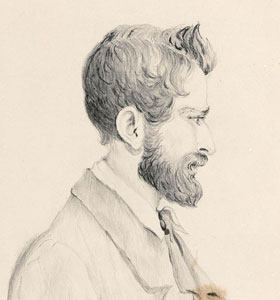Ludwig Leichhardt
Ludwig Leichhardt (1813-1848) was born in Prussia. After studying natural sciences in Germany and England he arrived in Sydney in 1842, where he pursued his interest in botany.

Ludwig Leichhardt, 28 May 1846, by Isobel Fox
Pencil drawing DG P1/4
In 1843, despite having poor eye sight and lacking any bush skills, Leichhardt decided to trek overland from the Hunter River region in NSW to Moreton Bay. This was an impressive adventure for such an inexperienced traveller. After this first trek, Leichhardt became determined to pursue his scientific interests by travelling into far North Queensland.
Leichhardt's first expedition
In 1844 Leichhardt led his first expedition to Port Essington, NT, departing from the Darling Downs, Qld, in October and reaching his destination in December 1845. The party crossed vast areas of previously unexplored territory and skirted the shores of the Gulf of Carpentaria. At one point they were given up for lost. Their surprise reappearance caused a national sensation.
- Follow Leichhardt's 1st expedition from Moreton Bay to Port Essington
- View the map detailing An overland expedition to Port Essington by L. Leichhardt

The discovery of new lands between Brisbane and the north of Australia, and Leichhardt's success in exploring country previously unknown to Europeans raised great interest. Following this expedition, Leichhardt became famous within the Australian colonies and in Europe, and his exploration achievements were recognised by gold medals from the Geographical Societies of London and Paris.
Leichhardt's second expedition
In 1848 Leichhardt set out on another expedition, hoping to cross the continent from east to west and follow the coast down to Perth. Leichhardt is believed to have given his compass and thermometer to a friend in Port Stephens, NSW before leaving for his last expedition.
In early April 1848, the expedition headed inland from the Darling Downs. Later that month the party disappeared without a trace.
The expedition's disappearance has been a mystery ever since. Many theories account for the disappearance of the party. The two most popular explanations are that the party perished in the desert or were attacked by Aboriginal people and all were killed. The most likely explanation is that Leichhardt and his party were killed by Aboriginal people.
> Discover more about Augustus Charles Gregory's expedition in search of Leichhardt in 1858
Lasting legacy
Leichhardt left behind a detailed record of his experiences in Australia in the form of field books, note books, journals and letters. His reputation as an explorer rests largely on his one successful expedition and the intriguing mystery of his disappearance during his attempt at an east-west crossing of Australia in 1848.
Many hoped that Burke and Wills' Victorian Exploring expedition, 1860-1861, might discover some trace of Leichhardt and his party.




